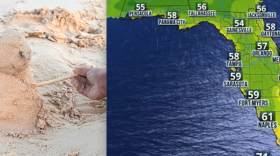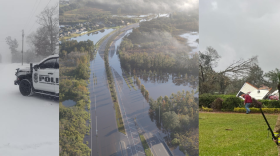A fact about global warming that may remain confusing for some time is that it can result in cold snaps, events such as the polar vortex sending frigid Arctic air deep from the North Pole region all the way down to the Sunshine State.
Twice this month temperatures have dropped to about 40 degrees in Southwest Florida and a third cold blast is forecast to arrive this weekend. It’s been so cold that during one day last week, half a dozen places in Florida were as cold or colder than Anchorage, Alaska.
Such bitter cold has meteorologists reaching for record books that haven’t been opened in some time, and people digging deep inside their closets for heavy sweaters and wool hats not worn in years. There is a good chance thermostats in homes from Jacksonville to Naples were turned up for the first time in a while, too.
Related story
Sea turtles and manatees are not built for cold snaps, and — pun intended — they don’t have such creature comforts.
But the endangered species do have a cadre of volunteers, and the Florida Fish & Wildlife Conservation Commission, to help the animals survive as they struggle to stay fully conscious in water that is getting way too cold for them. Temperatures drop rapidly in the shallow bays and along the beaches in Southwest Florida during a cold snap, sometimes by 2 degrees per day. At that rate, the risks to sea turtles and manatees – animals often in the shallows - can become dire.
Manatees can start to suffer from “cold stress,” a potentially fatal condition that slows their bodily functions. Prolonged exposure to lower water temperatures causes manatees to lose body heat and inadequately digest their food.
Without help from human volunteers the animals can, and do, die.
“Florida manatees, they're very dependent on environmental factors to survive, especially during the winter season,” said Michelle Pasawicz, Florida Fish & Wildlife Conservation Commission’s manatee management program administrator. “They are tropical, warm-blooded marine mammals. If manatees are exposed to water less than 60 degrees for prolonged periods of time, they can experience what we refer to as cold stress, which is similar to hypothermia in humans.”
And just as hypothermia can maim and kill people, cold stress can do the same to the sea cow.
‘Adverse impacts’
Manatees need access to water warmer than 68 degrees to survive prolonged cold weather. As temperatures drop, Florida manatees make their way to springs and warm-water discharge areas, which result in those familiar pictures of manatees bunched together near power plants in the winter. But not all make it.
“Unfortunately, when temperatures drop rapidly or remain low for significant periods of time,” Pasawicz said. “Some manatees might experience adverse impacts because they're not able to find those sources of warm water.”

When water temperatures drop below 50 degrees sea turtles in South Florida are also significantly impacted by cold snaps, because when water temperatures drop so do sea turtles’ body temperatures. Similar in name and in prognosis, “cold-stunning" leaves sea turtles weak, inactive, and unable to swim.
If the water temperature drops too fast, the animal can enter a potentially deadly stupor-like condition, become listless, or just float. They are often still alive but don’t look like it. This makes them extremely vulnerable to predators, boat strikes, and other hazards.
The effects of cold-stunning on sea turtles can vary depending on the severity and duration of exposure. Mild cases may resolve quickly once the turtle is warmed, but more severe cases can lead to pneumonia, infections, and other health problems. Juvenile sea turtles are particularly susceptible to cold-stunning as they have less body mass and fat reserves to help maintain their body temperature.
During cold snaps, wildlife officials and conservation organizations often rescue cold-stunned sea turtles, take them to animal hospitals, and gradually warm them back up. Once recovered, the turtles are released back into warmer waters or held until water temperatures rise to safe levels.

Cold stunning can happen anywhere along Florida’s coast. Biologists with the FWC’s Sea Turtle Program coordinate with authorized turtle “permit holders” who are trained to rescue sea turtles.
‘Don’t touch it. Report it’
If you see an injured, distressed or dead sea turtle or manatee, don’t touch it, report it. The FWC’s Wildlife Alert Hotline is 888-404-3922.
In response, volunteers and wildlife commission members will rescue, rehabilitate, and release all the animals they can save.
While challenging, this ongoing work is crucial for protecting these vulnerable species during unexpected cold snaps in the Sunshine State and the efforts have proven successful with many rescue centers reporting high survival rates for treated animals.
More information about sea turtles in Florida and how people can help with their conservation can be found at MyFWC.com/SeaTurtle.
Environmental reporting for WGCU is funded in part by VoLo Foundation, a non-profit with a mission to accelerate change and global impact by supporting science-based climate solutions, enhancing education, and improving health.
Sign up for WGCU's monthly environmental newsletter, the Green Flash, today.
WGCU is your trusted source for news and information in Southwest Florida. We are a nonprofit public service, and your support is more critical than ever. Keep public media strong and donate now. Thank you.








